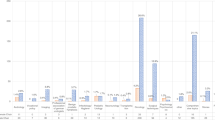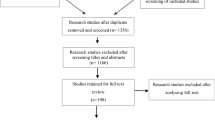Abstract
Background
Over the past 2 decades, there has been a growing interest in the significance of gender roles in healthcare and several efforts and initiatives have focused on increasing female representation in the medical field. Clinical trials play a very important role in shaping medical practice; moreover, the leaders of clinical trials often represent the upper echelon of researchers in any designated field. Presently, there is no data regarding women’s representation in urological oncology clinical trials leadership. Therefore, the aim of this study is to examine the extent of female representation in leading urological clinical trials.
Methodology
To thoroughly examine the representation of females as principal investigators (PIs) in urological cancer clinical trials between 2000 and 2020, we conducted a comprehensive search of completed trials focused on kidney, prostate, and bladder cancer on ClinicalTrials.gov. We extracted relevant information regarding the PIs and analyzed the data using univariate analyses to identify any significant differences between male and female PIs.
Results
A total of 9145 cancer clinical trials were conducted over the last 2 decades, and 11.3% (n = 1033) of them were urological cancer clinical trials. We were able to obtain detailed information about the principal investigators (PI) in 79.0% (n = 816) of the clinical trials, and we found that 16.8% (n = 137) of them were led by female investigators. Upon evaluating the characteristics of the PIs, female PIs had a significantly lower median age and median total citations as compared to male PIs (55.0 vs 59.0 and 5333 vs 7902; p-value < 0.001 and 0.006, respectively). However, there was no statistically significant difference between the termination rate, publication rate, funding source, cancer type, and the subject of conducting the clinical trials between male and female PIs.
Conclusion
Between 2000 and 2020, only 16.8% of urological cancer clinical trials were led by a female PI, perhaps reflective of a low percentage of senior female researchers in the fields of urology, oncology and radiation oncology. Universities, research institutes and funding agencies should work to improve mentorship, representation and opportunities for female investigators to encourage more involvement for female researchers in these clinical trials.

Similar content being viewed by others
Data availability
All data generated or analyzed during this study are included in this published article. The raw datasets used and/or analyzed during the current study can be obtained from the corresponding author upon reasonable request.
References
Ma L, Zhu K, Shi C, Chen X, Gao Y, Cai C et al (2023) Association between the patients’ symptom burden and their family caregivers’ benefit finding in non-small cell lung cancer receiving combined chemotherapy. Support Care Cancer 31:148
Borges EL, Franceschini J, Costa LHD, Fernandes ALG, Jamnik S, Santoro IL (2017) Family caregiver burden: the burden of caring for lung cancer patients according to the cancer stage and patient quality of life. J Bras Pneumol 43:18–23
Pérez-Sánchez S, Madueño SE, Montaner J (2021) Gender gap in the leadership of health institutions: the influence of hospital-level factors. Health Equity 5:521–525
Nonnemaker L (2000) Women physicians in academic medicine—new insights from cohort studies. N Engl J Med 342:399–405
Jagsi R, Biga C, Poppas A, Rodgers GP, Walsh MN, White PJ et al (2016) Work activities and compensation of male and female cardiologists. J Am Coll Cardiol 67:529–541
ClinicalTrials.gov. ClinicalTrials.gov Background. https://clinicaltrials.gov/ct2/about‐site/background (30 October 2020).
Sebo P (2021) How accurate are gender detection tools in predicting the gender for Chinese names? A study with 20,000 given names in Pinyin format. J Med Lib Assoc 110:205–211
(2023) Women in urology—closing the gap. Nat Rev Urol 20:385–385
Nam CS, Daignault-Newton S, Herrel LA, Kraft KH (2021) The future is female: urology workforce projection from 2020 to 2060. Urology 150:30–34
Gresham G, Meinert JL, Gresham AG, Meinert CL (2020) Assessment of trends in the design, accrual, and completion of trials registered in ClinicalTrials.gov by sponsor type, 2000–2019. JAMA Netw Open. 3:e2014682
Odei B, Kahn J, Holliday EB, Diaz DA, Bello-Pardo E, Odei J et al (2021) Where are the women in radiation oncology? A cross-sectional multi-specialty comparative analysis. Adv Radiat Oncol 6:100735
Reale S, Orecchia L, Ippoliti S, Pletto S, Pastore S, Germani S et al (2022) Is Urology a gender-biased career choice? A survey-based study of the Italian medical students’ perception of specialties. Front Surg. 9:1014036
Adams EJ, Louters MM, Kocsuta VA, Ganesh MB, Jang A, Ansbro B et al (2023) Gender disparities and differences among urologists included in top doctor lists. Urology 173:215–221
Solomon E, Reeves F, Challacombe B (2023) Women in urology: breaking down the barriers. Trends Urol Men’s Health 14:2–4
Feehan AK, Garcia-Diaz J (2020) Investigator responsibilities in clinical research. Ochsner J 20:44–49
Nielsen MW, Bloch CW, Schiebinger L (2018) Making gender diversity work for scientific discovery and innovation. Nat Hum Behav 2:726–734
Gabster BP, van Daalen K, Dhatt R, Barry M (2020) Challenges for the female academic during the COVID-19 pandemic. The Lancet 395:1968–1970
Gomez LE, Bernet P (2019) Diversity improves performance and outcomes. J Natl Med Assoc 111:383–392
Swartz TH, Palermo A-GS, Masur SK, Aberg JA (2019) The science and value of diversity: closing the gaps in our understanding of inclusion and diversity. J Infect Dis 220:S33-41
Boiko JR, Anderson AJM, Gordon RA (2017) Representation of women among academic grand rounds speakers. JAMA Intern Med 177:722
Files JA, Mayer AP, Ko MG, Friedrich P, Jenkins M, Bryan MJ et al (2017) Speaker introductions at internal medicine grand rounds: forms of address reveal gender bias. J Womens Health 26:413–419
Butkus R, Serchen J, Moyer DV, Bornstein SS, Hingle ST (2018) Achieving gender equity in physician compensation and career advancement: a position paper of the American College of Physicians. Ann Intern Med 168:721
Woolley AW, Chabris CF, Pentland A, Hashmi N, Malone TW (1979) Evidence for a collective intelligence factor in the performance of human groups. Science 2010(330):686–688
Han J, Stillings S, Hamann H, Terry R, Moy L (2017) Gender and subspecialty of urology faculty in department-based leadership roles. Urology 110:36–39
Baqain L, AlMajali R, Khanmammadova N, Dobbs RW, Nguyen TT, Semins MJ et al. (2024) Who are the mentors of the future endourologist? An analysis of Endourological Society Program Directors. J Endourol
Iversen AC, Eady NA, Wessely SC (2014) The role of mentoring in academic career progression: a cross-sectional survey of the Academy of Medical Sciences mentoring scheme. J R Soc Med 107:308–317
Acknowledgements
We extend our gratitude to the study participants for their invaluable contributions. In addition, we acknowledge the Deanship of Academic Research at the University of Jordan for their support in facilitating this research.
Funding
No specific funding was received for this work by the authors.
Author information
Authors and Affiliations
Corresponding author
Ethics declarations
Ethical approval
Not applicable.
Consent for publication
All the authors confirm the transfer of publication rights to the journal upon acceptance.
Conflict of interests
The authors affirm the absence of conflicts of interest.
Additional information
Publisher's Note
Springer Nature remains neutral with regard to jurisdictional claims in published maps and institutional affiliations.
Rights and permissions
Springer Nature or its licensor (e.g. a society or other partner) holds exclusive rights to this article under a publishing agreement with the author(s) or other rightsholder(s); author self-archiving of the accepted manuscript version of this article is solely governed by the terms of such publishing agreement and applicable law.
About this article
Cite this article
Alhajahjeh, A., Abdulelah, A.A., Hmeidan, M. et al. Gender inequality in genitourinary malignancies clinical trials leadership. World J Urol 42, 174 (2024). https://doi.org/10.1007/s00345-024-04893-7
Received:
Accepted:
Published:
DOI: https://doi.org/10.1007/s00345-024-04893-7




